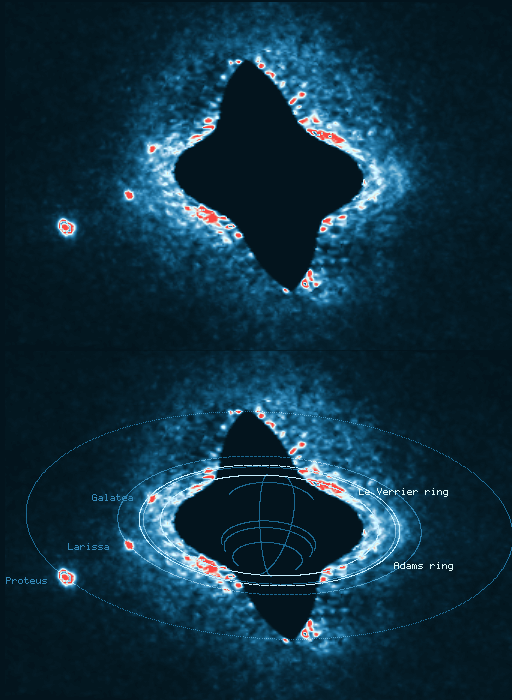
Satellites, Rings and Arcs around planet Neptune
Credit: Image courtesy of C. Roddier, F. Roddier, J.E. Graves, M. Northcott & O. Guyon,
Institute for Astronomy, Hawaii
(See also the refereed paper: Sicardy, B., et al. 1999, Nature, 400, 731.)

This picture is a deep, false-color composite image of Neptune showing
faint orbiting objects. The top image is as observed, with the bright
Neptune artificially masked to enhance contrast. The bottom panel
shows Neptune in silhouette, the orbits of the satellites Proteus,
Larissa and Galatea (the light blue lines) and the Le Verrier and
Adams rings (white lines).
The three satellites appear on the left side as red spots. They
are elongated due to their orbital motion during the 600sec exposure. The
Adams ring arcs are seen at western elongation (to the right of
Neptune), just outside Galatea's orbit.
Why are these observations important?
All four giant planets (Jupiter, Saturn, Uranus & Neptune) exhibit
ring systems. However, only Neptune have 'ring arcs', a collection of
incomplete narrow rings named Liberté,
Égalité, Fraternité and Courage. Interestingly,
these 'ring arcs' should be destroyed rapidly (over a few months) by
differential motion if they were in complete isolation. Yet, since first
discovered by stellar occultations in 1984, they appear to have
persisted. Gravitational resonance effects involving the satellite
Galatea in particular have been invoked to explain their long
lifetime. These observations of the ring arcs obtained at CFHT
indicate that the 'arcs' are near, but not within the resonance with
Galatea, in contrast to what is predicted and therefore calling for a
revision of the models.
Technical description:
This image was obtained by co-addition of nine 600-s exposures taken with Hokupa'a, the University of
Hawaii adaptive optics system, attached to the Canada-France-Hawaii
Telescope (CFHT) on July 6th, 1998. Data were acquired through a
narrow-band filter centered on a methane absorption band at 1.72µm, where Neptune is darker because it reflects and scatters less
light from the Sun. The image is 12 arcsec across, with a pixel size
of 0.035 arcsec. North is up and east is to the left.
The Adaptive Optics technique compensates image degradation produced
by the Earth's atmosphere. Neptune itself (behind the black mask) was
used as a guide source to probe the wave-front aberrations.



